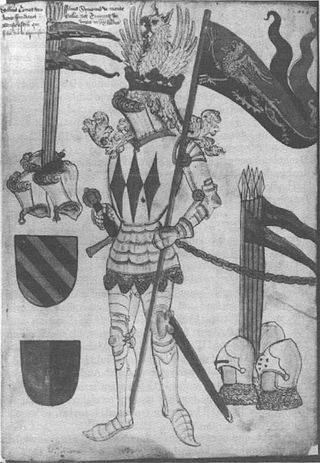Related Research Articles

Philippa of Clarence also known as Philippa Plantagenet or Philippa de Burgh was a medieval English princess and the suo jure Countess of Ulster.

William Montagu, alias de Montacute, 1st Earl of Salisbury, 3rd Baron Montagu, King of Man was an English nobleman and loyal servant of King Edward III.
Margaret Wake, suo jure3rd Baroness Wake of Liddell and Countess of Kent, was the wife of Edmund of Woodstock, 1st Earl of Kent, the youngest surviving son of Edward I of England and Margaret of France.

Thomas of Brotherton, 1st Earl of Norfolk, was the fifth son of King Edward I of England (1239–1307), and the eldest child by his second wife, Margaret of France, the daughter of King Philip III of France. He was, therefore, a younger half-brother of King Edward II and a full brother of Edmund of Woodstock, 1st Earl of Kent. He occupied the office of Earl Marshal of England.
Margaret of Norfolk or Margaret of Brotherton, Duchess of Norfolk in her own right, was the daughter and eventual sole heir of Thomas of Brotherton, eldest son of King Edward I of England by his second marriage. In 1338, she succeeded to the earldom of Norfolk and the office of Earl Marshal. In 1397, she was created Duchess of Norfolk for life.
Peter de Montfort of Beaudesert Castle was an English magnate, soldier and diplomat. He is the first person recorded as having presided over Parliament as a parlour or prolocutor, an office now known as Speaker of the House of Commons. He was one of those elected by the barons to represent them during the constitutional crisis with Henry III in 1258. He was later a leading supporter of Simon de Montfort, 6th Earl of Leicester against the King. Both he and Simon de Montfort were slain at the Battle of Evesham on 4 August 1265.

Lady Elizabeth de Montfort, Baroness Montagu was an English noblewoman.
Alice Montacute was an English noblewoman and the suo jure 5th Countess of Salisbury, 6th Baroness Monthermer, and 7th and 4th Baroness Montagu, having succeeded to the titles in 1428.
Elizabeth Stafford, Countess of Sussex was an English noblewoman.

Lady Anne Hastings, Countess of Huntingdon was an English noble. She was the daughter of Henry Stafford, 2nd Duke of Buckingham, and Catherine Woodville, sister of queen consort Elizabeth Woodville. She was first the wife of Sir Walter Herbert and then George Hastings, 1st Earl of Huntingdon, and served in the household of King Henry VIII's daughter, the future Queen Mary I.

Thomas Fitzalan otherwise Arundel, 10th Earl of Arundel, 7th Baron MaltraversKG was the son of William Fitzalan, 9th Earl of Arundel, and Joan Neville, eldest daughter of Richard Neville, 5th Earl of Salisbury, and Alice Montagu, suo jure Countess of Salisbury. By his mother, he was a nephew of Warwick, the Kingmaker.
Alice of Norfolk or Alice of Brotherton was an English noblewoman. She was the daughter of Thomas of Brotherton, and a granddaughter of King Edward I of England. She married Edward Montagu, 1st Baron Montagu.

William Ufford, 2nd Earl of Suffolk was an English nobleman in the reigns of Edward III and Richard II. He was the son of Robert Ufford, who was created Earl of Suffolk by Edward III in 1337. William had three older brothers who all predeceased him, and in 1369 he succeeded his father.

William Montagu, 2nd Baron Montagu, was an English peer, and an eminent soldier and courtier during the reigns of Edward I and Edward II. He played a significant role in the wars in Scotland and Wales, and was appointed steward of the household to Edward II. Perhaps as a result of the influence of his enemy, Thomas, 2nd Earl of Lancaster, Edward II sent him to Gascony as Seneschal in 1318. He died there in October of the following year.
Edward Montagu, 1st Baron Montagu was an English knight and peer. He fought at the Battle of Crecy. He assaulted his first wife, Alice of Norfolk, who died as a result.

William Willoughby, 5th Baron Willoughby de Eresby KG was an English baron.
Edward of Norfolk or Edward of Brotherton, was the only son of Thomas of Brotherton, and a grandson of King Edward I of England.
Margaret de Monthermer was an English heiress and suo jureBaroness Monthermer.
Aufrica de Connoght, also known as Affrica de Counnought, Affreca de Counnoght, Auffricia de Connaught, and Aufrica de Cunnoght, was a fourteenth-century woman who claimed to be an heiress of Magnús Óláfsson, King of Mann and the Isles, and who had some sort of connection with Simon de Montagu.
Amice was a Countess of Rochefort and suo jure countess of Leicester. She is associated with England but is thought to have spent most of her life in France.
References
- Cokayne, George Edward (1936). The Complete Peerage, edited by H.A. Doubleday and Lord Howard de Walden. Vol. IX. London: St. Catherine Press.
- Gross, Anthony (2004). "Montagu, William, second Lord Montagu (c.1285–1319)". Oxford Dictionary of National Biography (online ed.). Oxford University Press. doi:10.1093/ref:odnb/19000.(Subscription or UK public library membership required.)
- Ormrod, W.M. (2004). "Montagu, William, first earl of Salisbury (1301–1344)". Oxford Dictionary of National Biography (online ed.). Oxford University Press. doi:10.1093/ref:odnb/19001.(Subscription or UK public library membership required.)
- Richardson, Douglas (2011). Everingham, Kimball G. (ed.). Plantagenet Ancestry: A Study in Colonial and Medieval Families. Vol. II (2nd ed.). Salt Lake City. ISBN 978-1449966348.
{{cite book}}: CS1 maint: location missing publisher (link) - Robertson, Herbert (1893–1895). Stemmata Robertson et Durdin. London: Mitchell and Hughes. Retrieved 22 October 2013.
- Waugh, Scott L. (2004). "Thomas, first earl of Norfolk (1300–1338)". Oxford Dictionary of National Biography (online ed.). Oxford University Press. doi:10.1093/ref:odnb/27196.(Subscription or UK public library membership required.)